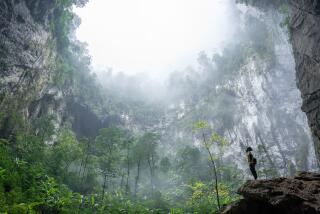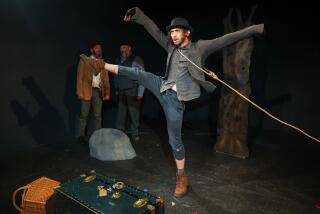Searching for Abraham and Ibrahim : ‘The Cave’ will be a multimedia piece on a Muslim and Jewish holy place
- Share via
JERUSALEM — The interviews all began with the same question: “To you, who is Abraham?” The answers run the gamut from pious to flippant. One deeply religious man said, “He’s my father,” while a museum curator snapped: “He’s a literary figure.”
The questions are being asked by minimalist composer Steve Reich and his wife, video artist Beryl Korot. They are collaborating professionally for the first time on “The Cave,” a multimedia work that will, when finished, have taken more than three years to complete and cost about $1 million.
The title refers to the Cave of Machpela, legendary burial site of the biblical patriarchs Abraham, Isaac and Jacob, and, according to lore, the secret passage to the Garden of Eden. Today, a cavernous structure built on the site by King Herod in the 1st Century BC still stands.
Reich calls his work a new kind of music theater that will combine his as-yet-uncomposed music with video footage of the cave, its surroundings and the videotaped interviews. “The Cave” will have its world premiere at the 1992-93 season of the Stuttgart Opera. The Reichs’ plans call for five 8x10-foot video screens and 18-24 musicians and singers to perform the work. The videotaped interviews explore Muslim-Jewish roots from the time of Abraham and the tensions that exist to this day.
Located in Hebron 25 miles south of Jerusalem on the West Bank, the cave is holy to the devout of both Jews and Muslims, and those of both faiths pray there under an intricate arrangement that seeks to minimize tension. In recent years, though, it has been a flash point of Israeli-Palestinian strife. Over the last few months some of the harshest confrontations between Palestinians and Jewish settlers have taken place there.
Tension around the area forced the Reichs to limit filming at the cave itself to about an hour. Armed Israeli soldiers are on patrol to keep the peace. As a result, the Reichs’ access to videotape was limited at the cave.
Last month, the Reichs interviewed Jews in Jerusalem and several West Bank locations. Early next year, the Reichs plan a return visit to Israel. Then they will interview Muslims and the question will be: “To you, who is Ibrahim?” They also plan to research and interview in Cairo.
At that point, they will probably confront an unwillingness to cooperate on the part of many religious leaders. Sheikh Mohamed Ismail Jamal Rifa’i, a high-ranking figure in the Jerusalem Islamic Council, dismissed the notion of speaking for the cameras out of hand.
“My religion forbids us to make a film about this subject,” he said. “It is far too holy. If people love the holy places, they should work for peace, not make films.”
Preliminary funding has come from the Rockefeller Foundation. ‘Cave’ co-commissioners include the Stuttgart Opera, Festival d’Automne a Paris, the South Bank Centre in London and the Brooklyn Academy of Music in New York.
Helga Utz, one of the dramaturgs at Stuttgart Opera, said that the Stuttgart Opera was looking forward to premiering “The Cave” because of the quality of the Reichs’ work, not because of its specific theme. That the Reichs are Jewish “is not really relevant,” she said. Nevertheless, Utz, 30, expressed hope that by premiering on German soil, “The Cave” may contribute to the healing process between the Germans and the Jews.
“The Germans are more sensitive to the Israeli position than any other European country,” Utz continued. “It’s harder for us to judge them, because of the past.”
While he was in Stuttgart last fall, Reich told Stuttgart Opera’s chief dramaturg Klaus-Peter Kehr about his plans to work with Korot. Kehr wasted little time in commissioning the project. “I was very interested to do the first music theater piece by Steve Reich,” Kehr said. “We try to stay very close to the American scene and we performed several pieces by Phillip Glass last season.”
The agreement was reached before Reich and Korot had settled on a subject for their collaboration. Kehr acknowledged that the subject was sensitive in Germany, due to German-Jewish history and the Holocaust. Nevertheless, he said he looks forward to dealing with the subject.
“We are interested in all political situation,” he said. “We like to work with political art.”
Art cannot repair the damage done under the Third Reich, he said, but it can contribute to Germany’s efforts to build a good relationship with Israel and Jews around the world.
“Art can plead for understanding in a very effective way,” he said.
Reich and Korot have returned home to New York after spending two weeks last month on location in Jerusalem, Hebron and the surrounding areas.
The Reichs first learned about the cave through their studies of Jewish sources, and they were intrigued by stories calling it a secret passage to the Garden of Eden.
Since embarking on this project, the biblical ancestors have become real-life figures for them. “Abraham, Isaac, Jacob, Sarah, Ishmael and Hagar are the stars of our show,” Reich said with a laugh.
The first two parts of “The Cave,” entitled “Abraham and Isaac” and “Abraham and Ishmael,” have started to take shape, but Korot said the final part, “The Death of Abraham,” is still a blank slate.
In two trips there, they have recorded more than 60 hours of videotaped interviews with a wide range of Jews in which they attempt to uncover the significance of the cave--and the biblical forefathers--to each individual.
Before bringing Korot’s video equipment inside, they needed clearance from the Muslim and Jewish religious leaders at the site, and from Israeli military authorities. Then they chose a day and a time when they hoped tensions would be at a minimum.
Their understanding of the cave was enhanced by Rivka Gonen, curator of the Israel Museum’s department of Jewish ethnography. She explained that the “cave” is actually a narrow shaft dug by man into the rocky earth.
“It’s just wide enough for a person to fit, and to carry the dead to a small room, about 6-8 feet wide, at the bottom,” she said.
Islamic archeologist Issa Baidun emphasized that for religious Muslims the cave ranks high. After completing the pilgrimage to Mecca, he said, many devout Muslims visit Al-Aksa and the Cave of Machpela, which they call the Ibrahim Mosque.
Reich says that “The Cave” will not be like other recent minimalist operas.
“Composing operas in this day and age is just plain ridiculous. Singing on stage in a bel canto or Wagnerian style with an orchestra in the pit just doesn’t make sense anymore.
“Why should we be locked into a style that was developed to fit the technologies and situations of the past? You have to look around you and see what’s new. You have to develop a style that’s relevant.”
So far the best indication of what “The Cave” will be like comes from looking at some previous Reich and Korot works.
Reich, 52, first tapped into his Jewish traditional spiritual roots in the 1980s with compositions such as “Tehillim” and his latest work, “Different Trains,” which merges music and recorded voices to tell a personal story of growing up in America during the 1940s.
In the mid-1970s, Korot pioneered multiscreen video production with her much-acclaimed “Dachau 1974.” It has recently been referred to as a classic of the early video era and was one of three productions featured in a 1988 exhibition at the Long Beach Museum of Art called “Planes of Memory.”
But “The Cave” promises to be much bigger than anything either of them has done before. The travel expenses alone far outstrip their past projects.
----
Alice Shalvi, head of the feminist Israel Women’s Network and principal of a religious Jewish girls’ high school, said: “Instead of continuing to be a source of friction, the cave could be a source of reconciliation, and I think the descendants of Sarah and Hagar need to be key players in this reconciliation--namely, the women.”
Shalvi called “The Cave” a wonderful project and expressed satisfaction that the Reichs have “hit on an issue that epitomizes Israeli-Palestinian relations.”
Not everybody agrees. Octogenarian scholar Yeshayahu Leibovitz agreed to let the Reichs interview him, but promptly told them what he thought of their project.
“I asked them why they were interested in the Cave of Machpela, but I did not get an answer,” he said after being interviewed for the project. “I certainly have no interest in the cave.”
A religious man, Leibovitz nonetheless dismisses much conventional religious wisdom. For example, he has never accepted the notion of holy places. “Holiness is in observing God’s commandments,” he said, “not in worshipping a place.”
In the final analysis, the Reichs say they are not creating “The Cave” in order to win the support of people like Shalvi or Leibovitz. It is part of a personal quest, a need to take professional risks and do unique work.
“The 1980s are a very conservative period,” Reich concluded. “Other people can write music for orchestras, but nobody will do ‘The Cave’ unless we do it ourselves.”
More to Read
The biggest entertainment stories
Get our big stories about Hollywood, film, television, music, arts, culture and more right in your inbox as soon as they publish.
You may occasionally receive promotional content from the Los Angeles Times.










